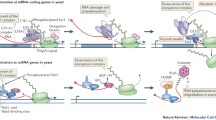Abstract
In most eukaryotes, the generation of the 3′ end and transcription termination are initiated by cleavage of the pre-mRNA upstream of the polyadenylation site. This cleavage initiates 5′–3′ degradation of the 3′ end cleavage product by the exoribonuclease Rat1p leading to the dissociation of the RNA polymerase II (RNAPII) complex. The Rat1p-dependent transcription termination was also shown to be initiated by a polyadenylation-independent cleavage performed by the double-stranded RNA-specific ribonuclease (RNase) III (Rnt1p) suggesting that the majority of transcription termination events are RNase dependent. Therefore, it became essential for future studies on transcription termination to carefully consider both the nature of the RNase-dependent RNA transcripts and the association pattern of the RNAPII with the transcriptional unit. Here, we present methods allowing the evaluation of the impact of yeast RNases on the 3′ end formation and their contribution to transcription termination. Northern blot analysis of transcripts generated downstream of known genes in the absence of RNases identifies potential transcription termination sites while chromatin immunoprecipitation of RNAPII differentiates between termination- and transcription-independent processing events.
Access this chapter
Tax calculation will be finalised at checkout
Purchases are for personal use only
Similar content being viewed by others
References
Prescott EM, Osheim YN, Jones HS, et al (2004) Transcriptional termination by RNA polymerase I requires the small subunit Rpa12p. Proc Natl Acad Sci USA 101:6068–73
Cui M, Allen MA, Larsen A, Macmorris M, Han M, Blumenthal T (2008) Genes involved in pre-mRNA 3′-end formation and transcription termination revealed by a lin-15 operon Muv suppressor screen. Proc Natl Acad Sci USA 105:16665–70
Zarudnaya MI, Kolomiets IM, Hovorun DM (2002) What nuclease cleaves pre-mRNA in the process of polyadenylation? IUBMB Life 54:27–31
Tollervey D (2004) Molecular biology: termination by torpedo. Nature 432:456–7
Luo W, Bentley D. (2004) A ribonucleolytic rat torpedoes RNA polymerase II. Cell 119:911–4
West S, Gromak N, Proudfoot NJ (2004) Human 5′→3′ exonuclease Xrn2 promotes transcription termination at co-transcriptional cleavage sites. Nature 432:522–5
Kim M, Vasiljeva L, Rando OJ, Zhelkovsky A, Moore C, Buratowski S (2006) Distinct pathways for snoRNA and mRNA termination. Mol Cell 24:723–34
Carroll KL, Pradhan DA, Granek JA, Clarke ND, Corden JL (2004) Identification of cis elements directing termination of yeast nonpolyadenylated snoRNA transcripts. Mol Cell Biol 24:6241–52
Osheim YN, French SL, Keck KM, et al (2004) Pre-18 S ribosomal RNA is structurally compacted into the SSU processome prior to being cleaved from nascent transcripts in Saccharomyces cerevisiae. Mol Cell 16:943–54
Steinmetz EJ, Warren CL, Kuehner JN, Panbehi B, Ansari AZ, Brow DA (2006) Genome-wide distribution of yeast RNA polymerase II and its control by Sen1 helicase. Mol Cell 24:735–46
Egloff S, O’Reilly D, Murphy S (2008) Expression of human snRNA genes from beginning to end. Biochem Soc Trans 36:590–4
Richard P, Manley JL (2009) Transcription termination by nuclear RNA polymerases. Genes Dev 23:1247–69
Ghazal G, Gagnon J, Jacques PE, Landry JR, Robert F, Elela SA (2009) Yeast RNase III triggers polyadenylation-independent transcription termination. Mol Cell 36:99–109
Rondon AG, Mischo HE, Kawauchi J, Proudfoot NJ (2009) Fail-safe transcriptional termination for protein-coding genes in S. cerevisiae. Mol Cell 36:88–98
Taggart AK, Teng SC, Zakian VA (2002) Est1p as a cell cycle-regulated activator of telomere-bound telomerase. Science 297:1023–6
Lamontagne B, Tremblay A, Abou Elela S (2000) The N-terminal domain that distinguishes yeast from bacterial RNase III contains a dimerization signal required for efficient double-stranded RNA cleavage. Mol Cell Biol 20:1104–15
David L, Huber W, Granovskaia M, et al (2006) A high-resolution map of transcription in the yeast genome. Proc Natl Acad Sci U S A 103:5320–5
Rozen S, Skaletsky H (2000) Primer3 on the WWW for general users and for biologist programmers. Methods Mol Biol 132:365–86
SantaLucia J, Jr (1998) A unified view of polymer, dumbbell, and oligonucleotide DNA nearest-neighbor thermodynamics. Proc Natl Acad Sci U S A 95:1460–5
Brosseau JP, Lucier JF, Lapointe E, et al (2010) High-throughput quantification of splicing isoforms. RNA 16:442–9
Lopez R, Silventoinen V, Robinson S, Kibria A, Gish W (2003) WU-Blast2 server at the European Bioinformatics Institute. Nucleic Acids Res 31:3795–8
Laemmli UK (1970) Cleavage of structural proteins during the assembly of the head of bacteriophage T4. Nature 227:680–5
Catala M, Tremblay M, Samson E, Conconi A, Abou Elela S (2008) Deletion of Rnt1p alters the proportion of open versus closed rRNA gene repeats in yeast. Mol Cell Biol 28:619–29
Cherry JM, Ball C, Weng S, et al (1997) Genetic and physical maps of Saccharomyces cerevisiae. Nature 387:67–73
Acknowledgments
This work was supported by grants from the Natural Sciences and Engineering Research Council of Canada (NSERC) and the Canadian Institute of Health Research (CIHR).
Author information
Authors and Affiliations
Corresponding author
Editor information
Editors and Affiliations
Rights and permissions
Copyright information
© 2012 Springer Science+Business Media, LLC
About this protocol
Cite this protocol
Ghazal, G., Gagnon, J., Elela, S.A. (2012). Detection and Characterization of Transcription Termination. In: Vancura, A. (eds) Transcriptional Regulation. Methods in Molecular Biology, vol 809. Springer, New York, NY. https://doi.org/10.1007/978-1-61779-376-9_38
Download citation
DOI: https://doi.org/10.1007/978-1-61779-376-9_38
Published:
Publisher Name: Springer, New York, NY
Print ISBN: 978-1-61779-375-2
Online ISBN: 978-1-61779-376-9
eBook Packages: Springer Protocols




